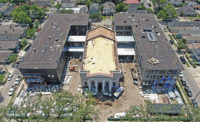COVID–19 shifted the way the world interacts, forcing all of us to change our routines and adapt to a completely different lifestyle. The pandemic also has increased awareness of how isolation affects us, including aging seniors, and has reinforced my belief in the importance of keeping empathy at the forefront of the design process for senior-living environments.
Over the past year, I’ve had discussions with our health care and senior-living studio designers as well as senior-living developers, operators and caregivers to uncover design elements that could help answer important questions that have arisen in response to COVID. For example, how can design help fight loneliness for residents of these communities? Before the pandemic, how did residents maintain their independence? Were they capable of getting around their communities to dine, socialize and stay healthy? What part can design play in slowing the spread of the flu or any other virus, such as COVID? The following are some ideas that may be beneficial in allowing seniors to stay safe and fully engage in their communities.
Many studies have shown that loneliness can lead to dementia. During the pandemic, people mitigated isolation through Zoom, FaceTime or other online platforms. But buildings must have ample infrastructure to support these technologies, including telemedicine and monitoring capabilities that help determine when residents need a caregiver. Amazon Echo (aka Alexa) and Google Home can help seniors with many daily tasks, including light and temperature controls in their units. Most systems require minimal effort to retrofit for these devices. Touchless faucets, toilet flush valves, light sensors and other technology also should be considered in communal areas. Copper or silver nanoparticles imbedded in highly touched surfaces are toxic to germs.
Automatic door openers should be installed at all exterior doors, with override capabilities to lock down as needed for security. A relatively low-cost option for existing buildings are duct sanitizers, which can be added to the ductwork. The “no-maintenance” air purifiers are easy to install but require power for operation. Designers should consider using antimicrobial filters in all mechanical equipment. Carpet, wall coverings and countertops also can be finished with antimicrobial materials.
The use of smaller community spaces allows for safer socialization in areas where the mechanical system creates negative pressure. Residents who are infected can be isolated in those spaces while maintaining physical separation and allowing for some socialization.
Storage areas are non-revenue generating, which means in most cases, senior communities have limited space for storing personal protective equipment (PPE). However, communities with multiple sites can rent space in a central location to store these materials.
Another concept worth exploring is rearranging the entry sequence for buildings by locating an office adjacent to the entry. This space will have a “pass-through” window that can be located behind a piece of artwork, a decorative panel or concealed with a flush panel that can be removed so the window can operate. All other doors can be locked down for entry, making sure not to impede the egress requirements and ensuring anyone entering the building through the main entry can be screened as necessary. These changes will make buildings safer and more user friendly for residents.




Post a comment to this article
Report Abusive Comment